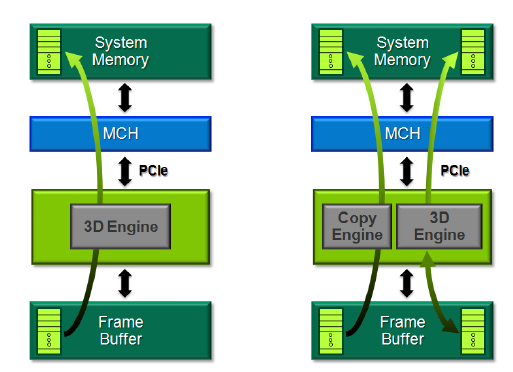The technical magic, and platform considerations
Getting around the multiplexer - the technical bitHaving no hardware multiplexers begs the question as to how the mGPU's output is pushed through to the IGP's display controller. Once the mGPU is made active, the Optimus Copy Engine (another great marketing-speak name) grabs the mGPU's output (frame-buffer contents), which would normally be sent out to its own display controller(s), and then transfers them over the PCIe lanes and into the IGP's frame buffer, defined as system memory.

In normal circumstances, 3D rendering stops when the GPU-outputted data is thrown over to the IGP's pool of memory. The reason for doing so lies with keeping coherency. Having Optimus' GPU wait every time the export takes place would lead to haemorrhaged performance. Getting around this, by using the PCIe lanes' bi-directional ability to route traffic, Optimus, NVIDIA says, enables the GPU to function at full speed whilst pushing its output into the IGP. In effect, then, the IGP is used as a fully-functioning go-between, instead of having separate traces and multiplexers.
This go-between behaviour is the crux of how Optimus works. The mGPU simply rides on the back of the IGP at all times, switched off when not necessary and, via the routing layer, running through the IGP when required: all through the same outputs. The upshot is near-instant switching between the states, because the mGPU and IGP don't fight it out for the right to be the display output of choice.
Platform considerations
NVIDIA will roll Optimus into the GeForce 300M, GeForce 200M, and upcoming ION 2 mGPUs, along with future support for Fermi-based cards, we imagine. As the video is pushed through the IGP and needs validation (at least from NVIDIA's part), qualified mobile platforms will include Arrandale-based Core i3, Core i5, Core i7; Core 2 Duo (Penryn) and Atom N400-series chips. The range covers practically Intel's entire current catalogue of mobile CPUs and an eclectic bunch of integrated graphics. We wonder what Intel has to say about NVIDIA's vicarious use of its IGPs as video mules.
The technical explanation gives you an insight into how Optimus works - it's the ultimate display parasite - so let's now see it in action on an ASUS notebook.


